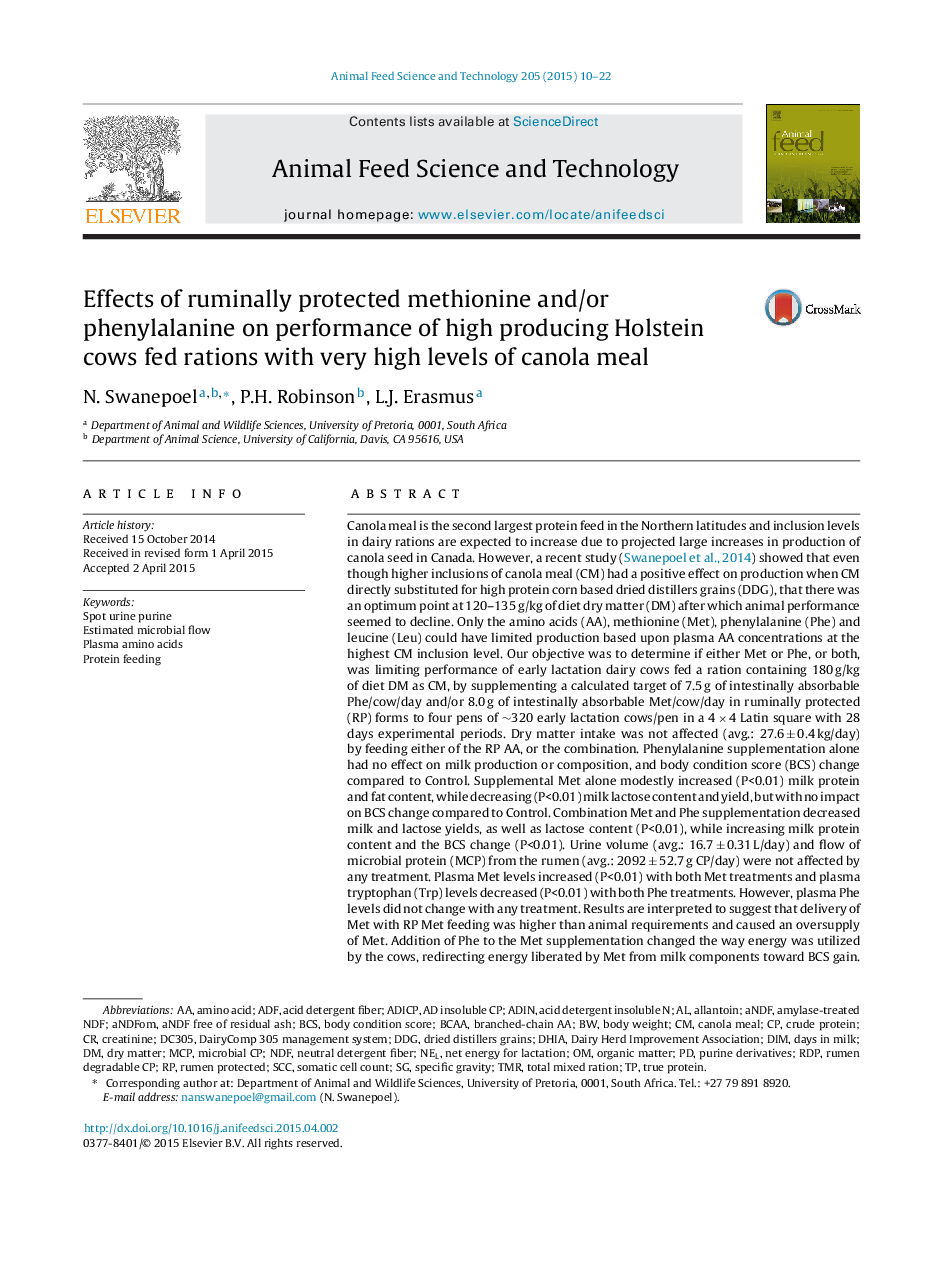| کد مقاله | کد نشریه | سال انتشار | مقاله انگلیسی | نسخه تمام متن |
|---|---|---|---|---|
| 8491347 | 1552380 | 2015 | 13 صفحه PDF | دانلود رایگان |
عنوان انگلیسی مقاله ISI
Effects of ruminally protected methionine and/or phenylalanine on performance of high producing Holstein cows fed rations with very high levels of canola meal
ترجمه فارسی عنوان
اثرات متیونین و / یا فنیل آلانین محافظت شده بر روی عملکرد گاوهای تولید کننده هولشتاین تولید شده با جیره های دارای میزان بسیار بالایی از وعده های غذایی کلزا
دانلود مقاله + سفارش ترجمه
دانلود مقاله ISI انگلیسی
رایگان برای ایرانیان
کلمات کلیدی
NDFmicrobial CPADFDairy Herd Improvement AssociationRumen protectedaNDFMCPSCCRDPTMRDDGADICPaNDFomADIN - آدینAllantoin - آلتوئینamino acid - آمینو اسیدDIM - اذعانPlasma amino acids - اسید آمینه پلاسماacid detergent fiber - الیاف پاک کننده اسیدnet energy for lactation - انرژی خالص برای شیردهیBCAA - بی سی ای ایSomatic cell count - تعداد سلول های سوماتیکProtein feeding - تغذیه پروتئینDried distillers grains - دانه های خشک شده خشک شدهNEL - درdays in milk - روز در شیرBCs - روند BCsbranched-chain AA - زنجیره ای AACanola meal - غذای کانولاneutral detergent fiber - فیبر مواد شوینده خنثیorganic matter - ماده آلیdry matter - ماده خشکPurine derivatives - مشتقات پورینacid detergent insoluble N - مواد شوینده اسیدی N نامحلول استBody condition score - نمره وضعیت بدنbody weight - وزن بدنSpecific gravity - وزن مخصوصcrude protein - پروتئین خامtrue protein - پروتئین واقعیcreatinine - کراتینینtotal mixed ration - کل جیره مخلوط شده
موضوعات مرتبط
علوم زیستی و بیوفناوری
علوم کشاورزی و بیولوژیک
علوم دامی و جانورشناسی
چکیده انگلیسی
Canola meal is the second largest protein feed in the Northern latitudes and inclusion levels in dairy rations are expected to increase due to projected large increases in production of canola seed in Canada. However, a recent study (Swanepoel et al., 2014) showed that even though higher inclusions of canola meal (CM) had a positive effect on production when CM directly substituted for high protein corn based dried distillers grains (DDG), that there was an optimum point at 120-135 g/kg of diet dry matter (DM) after which animal performance seemed to decline. Only the amino acids (AA), methionine (Met), phenylalanine (Phe) and leucine (Leu) could have limited production based upon plasma AA concentrations at the highest CM inclusion level. Our objective was to determine if either Met or Phe, or both, was limiting performance of early lactation dairy cows fed a ration containing 180 g/kg of diet DM as CM, by supplementing a calculated target of 7.5 g of intestinally absorbable Phe/cow/day and/or 8.0 g of intestinally absorbable Met/cow/day in ruminally protected (RP) forms to four pens of â¼320 early lactation cows/pen in a 4 Ã 4 Latin square with 28 days experimental periods. Dry matter intake was not affected (avg.: 27.6 ± 0.4 kg/day) by feeding either of the RP AA, or the combination. Phenylalanine supplementation alone had no effect on milk production or composition, and body condition score (BCS) change compared to Control. Supplemental Met alone modestly increased (P<0.01) milk protein and fat content, while decreasing (P<0.01) milk lactose content and yield, but with no impact on BCS change compared to Control. Combination Met and Phe supplementation decreased milk and lactose yields, as well as lactose content (P<0.01), while increasing milk protein content and the BCS change (P<0.01). Urine volume (avg.: 16.7 ± 0.31 L/day) and flow of microbial protein (MCP) from the rumen (avg.: 2092 ± 52.7 g CP/day) were not affected by any treatment. Plasma Met levels increased (P<0.01) with both Met treatments and plasma tryptophan (Trp) levels decreased (P<0.01) with both Phe treatments. However, plasma Phe levels did not change with any treatment. Results are interpreted to suggest that delivery of Met with RP Met feeding was higher than animal requirements and caused an oversupply of Met. Addition of Phe to the Met supplementation changed the way energy was utilized by the cows, redirecting energy liberated by Met from milk components toward BCS gain. It remains unclear if Phe was limiting in the Control ration or if RP Phe was not fed at high enough levels to have a measurable response on production. However, it is clear that AA limitations, requirements and production responses are governed by much more than plasma AA levels. Results further suggest that AA are bioactive metabolites to the extent that they can change animal performance, even when they are not “limiting” per se, and that their supplementation to practical dairy cattle diets should be approached with extreme caution for this reason.
ناشر
Database: Elsevier - ScienceDirect (ساینس دایرکت)
Journal: Animal Feed Science and Technology - Volume 205, July 2015, Pages 10-22
Journal: Animal Feed Science and Technology - Volume 205, July 2015, Pages 10-22
نویسندگان
N. Swanepoel, P.H. Robinson, L.J. Erasmus,
